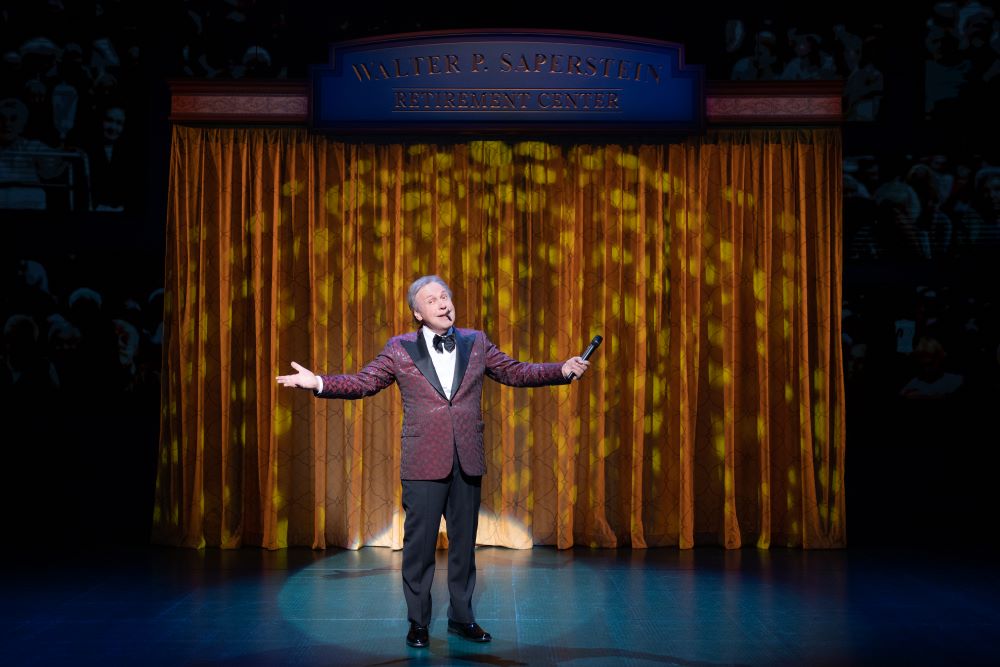Opening on Broadway in late April, “Mr. Saturday Night” stars Billy Crystal in a musical adaptation of his self-directed 1992 film of the same name that’s currently appearing at the 1,232-seat Nederlander Theater, supported by Tony Award-winning sound designer Kai Harada’s custom-tailored reinforcement system employing 90 Meyer Sound loudspeakers selected from 11 different current and legacy models.
Harada was familiar with the room acoustics as the Nederlander Theater also hosted the hit Million Dollar Quartet (MDQ) in the 2010–11 season and also marked Harada’s first credit as a principal Broadway sound designer.
“The Meyer Sound system for MDQ worked very well in the room, but I basically started from scratch for this design,” says Harada. “This is a differently styled show, as it is a more natural-sounding musical. Also, they recently changed the orchestra audience rake, so I wanted to start from the beginning, not to mention we now have to deal with the HVAC fans running full-on at all times to comply with COVID airflow regulations. And I definitely wanted to take advantage of newer Meyer Sound models like LINA and ULTRA-X40.”
The three front arrays are all current models with seven-each hangs of LEOPARD compact linear line array loudspeakers at stage left and right and a center cluster of five LINA very compact linear line array loudspeakers to cover the front orchestra section.
“I really like the linearity of the LINAs, and they are very controlled in their coverage,” notes Harada. “But I still like the M1Ds in some applications. They are good for natural sounding vocals, and with the very small form factor — height in particular — I can fit in more cabinets where array size limit is critical.”
Wherever a point source approach is called for, Harada’s goes with the ULTRA-X40 compact loudspeaker. “It is exceptionally good for both vocal and orchestral reinforcement,” he says. “One reason is the linearity; it requires less EQ than the UPA, for example. Also, the rotatable horn in the center is particularly useful on Broadway, as often I have to hang horizontally or vertically because of sightlines or aesthetics. I will never do another show without ULTRA-X40s.”
Eight ULTRA-X40 loudspeakers are employed for downfill, orchestra source, and balcony fill. Other models in the system, with total number and applications, are 14 M1D line array loudspeakers (mezzanine arrays), 4 UPQ‑1P loudspeakers (stalls left and right, orchestra source), 14 UPM-1P loudspeakers (box fill, foldback), eight UPJunior loudspeakers (stalls delay), and 13 MM-4 miniature loudspeakers (front fill, foldback). Deep bass registers are filled by four 500-HP and two 600-HP subwoofers. All audio equipment for the production is supplied by Masque Sound.
Regardless of specific application, Harada strongly prefers self-powered loudspeakers for his main and foldback systems. “Many Broadway theaters have limited space for amp racks,” he says. “And there are more things that can go wrong with troubleshooting between front-of-house and the loudspeaker when you have amp racks in the middle. Also, it’s so easy to make revisions and additions, especially for fill systems or stage foldback. If I find a spot that is lacking in coverage than expected and I need another speaker, I just plug one in and go. True, other companies are jumping on the self-powered bandwagon, but they don’t offer the overall quality and support I get from Meyer Sound.”
Harada credits the show’s entire audio crew for a successful effort, including associate sound designers Maggie Burke and Bella Curry, mixer John Kauble, production sound engineer Mike Wojchik, backstage tech Lukas Guilbeau, as well as the team at Masque Sound.
Kai Harada received the 2018 Tony Award for Best Sound Design in a Musical for The Band’s Visit. His other Broadway credits include Head Over Heels, Amélie, Sunday in the Park with George, Allegiance, Gigi, Fun Home, On the Town, First Date, and Follies. He also has designed numerous other plays and musicals for off-Broadway, touring, and regional theater productions.




















